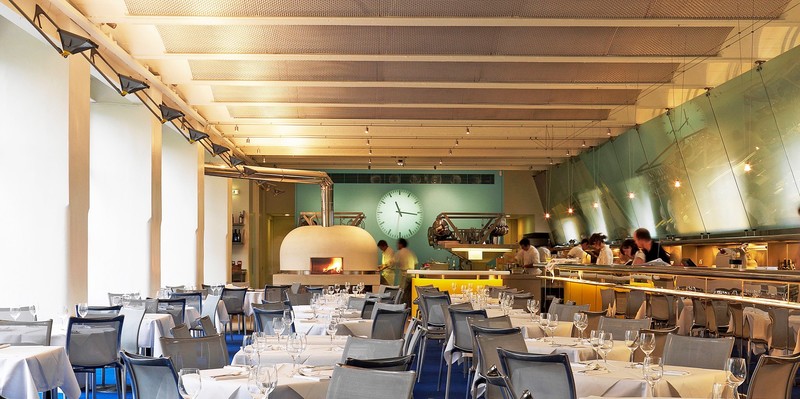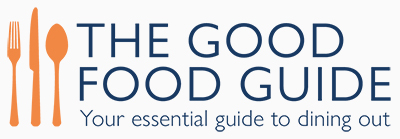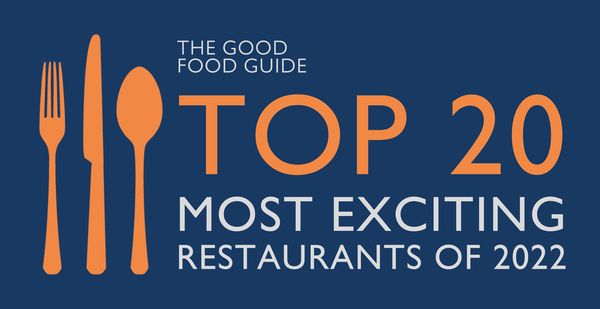 The Good Food Guide 1989
The Good Food Guide 1989
Opposite the mammoth grey bulk of Charing Cross hospital is a hinterland of two-storey terraced houses. This once working-class heartland is now suburbia, sandwiched between the flats and warehouses fronting the river and the furore of the Fulham Palace Road, but it remains time-warped. Richard Rogers, guru of hi-tec architecture, occupies two of the warehouses fronting the river, and has transformed them; through the entrance gap is a gigantic steel-panelled staircase painted white, and in the middle of the three-sided terrace stands a revolving sculpture of blue pencils that whirl incessantly. Ruthie Rogers runs the vaulted restaurant that was originally the canteen for the Thames Wharf Studios. It still offers lunch only, but is a genuine attempt to produce unfussy cucina rustica, Italian farmhouse cooking, in a fashionable outpost of the capital. The power of the food shows in excellent farfalline with sun-dried tomatoes and basil, and grilled calf’s liver with polenta and wild mushrooms. Roast leg of lamb comes stuffed with herbs and garlic, accompanied by lentils and white bean purée. The short menu can also take in roasted red and yellow peppers with tapenade, grilled fillet of red mullet with courgette salad, pan-fried scallops with fennel purée. To finish there is good apricot tart or fromage frais with strawberry purée. House wine is Montepulciano d’Abruzzo at £5.
 The Good Food Guide 1999
The Good Food Guide 1999
Clean lines, self-assured design, and a smattering of famous faces help to make this a seriously ‘chic’ place to eat at. It embodies a simple, open style if Italian cooking, at the same time glamorising the fertile repertoire of peasant food in which fish and vegetables play a significant role. The wood-fired oven is a boon, although it can also roast nearby customers. This ancient yet fashionable cooking method (which needs skilful handling) is applied to anything from turbot to guinea fowl, the latter stuffed with prosciutto, mascarpone and thyme, and served with lentils, herbs and rocket.
Despite translations, dishes are awash in apparently baffling ingredients – pagnotti, salmoriglio, granchio, rombo – that seem to demand A-level menu Italian to decode. But waiters ‘delight in the opportunity this gives them for instruction,’ and reporters don’t mind too much in view of the exemplary results that appear. This is confident food, producing bruschetta with a mound of Cornish crab and unfussy herb salad, or an impressive dish of polenta (how often does this happen?) with a mix of girolles, trompettes and pied de mouton, enlivened with a hefty dose of garlic. Bollito misto may be more homely than fashionable but is still carefully cooked, and served with mostarda de Cremona.
Textbook chocolate nemesis is as smooth and rich as can be, and caramel ice-cream has been ‘stunning’. Tables have time limits, prices are high, and not all reporters are equally happy with their food, citing disappointments with risotto, the texture of meat (lamb in particular), and ‘elusive’ tastes, but all that is par for the course here: it simply doesn’t speak to everyone. At its best service is friendly and well informed, though it can be ‘detached’, and there are many grumbles about unsympathetic treatment. The all-Italian wine list (champagne excepted) has been expanded by four pages of ‘reserve wines’, some from older vintages. Puiatti’s elegant Collio Chardonnays, Aldo Conterno’s grand Barolos and Selvapiana’s renowned ‘Bucerchiale’ Chianti Rufinas are just a few of the welcome arrivals. House wines are £9.50.
 The Good Food Guide 2000
The Good Food Guide 2000
No doubt most people who have watched Rose Gray and Ruth Rogers cooking on TV want to experience it first hand. The food looks fresh and exciting, and appears to be produced effortlessly in seconds. Who can resist? And therein lies a problem. ‘If ever a place has become too popular for its own good, this one is as good an example as you will find.’ Given its popularity, there is understandably pressure on its close-together tables; hence there is a time limit, we are told, on 20 per cent of them. This and the attendant booking problems, plus service that can be ‘rushed and forgetful’, and dishes that run out, can make it all seem ‘more like a military operation than eating out’. This highly processed feel is at odds with the informal style of food, and with what Italians consider normal.
The saving grace is that, when it comes, the food is all but universally praised, by first-timers for its quality, by regulars for its consistency: ‘particularly fine’ sardines, ‘the best squid I ever had’, ‘exceptional’ turbot, and pork ‘with real flavour’ served with spinach and balsamic sauce. Simplicity is a keynote – in tagliatelle with nettles, butter and Parmesan, for example – and one reporter with a late lunch slot, who found little beyond a green salad with lots of herby flavours’, a plate of ‘pretty good cheese’, and a tasty caramel ice cream, certainly enjoyed the lot. Wood roasting, too, is a particularly successful technique: perhaps spatchcocked Bresse pigeon with a spinach and porcini gratin. To finish, chocolate nemesis provided one reporter with a ‘moment of brilliance’. Except for champagnes, the wine list is all Italian and offers a wide array of styles and flavours from historical to ultra-modern. House wines are £9.50 but do take a look at the seasonal selection of reserved wines for older vintages from the likes of Also Conterno, Angleo Gaja and Monte Vertine.
 The Good Food Guide 2007
The Good Food Guide 2007
Rose Gray and Ruth Rogers have been flying the flag for new-wave Italian cooking for twenty years and, media brouhaha and time restraints on tables notwithstanding, the River Café is as sharp and cosmopolitan as ever. The white dining room feels restrained but not austere, while the flickering wood-burning oven catches the eye. The simple and uncluttered presentation of dishes highlights the care and precision of the cooking and the understated approach. Menus change with each service while seasonality, natural flavours and avoidance of gimmickry are the watchwords. Fish is accurately timed and often lifted by a lightly spicy accompaniment: say antipasti of crab with bruschetta, chilli, fennel seeds, agretti, olive oil and lemon, or a main of chargrilled monkfish with chilli and mint sauce, deep-fried lemon slices and artichoke and mâche salad. Freshness, timing and balance combine to give the food vitality. And meat dishes equally accomplished could include pigeon, T-bone beefsteak, or perhaps osso buco served with saffron risotto. To finish, unerringly applied craftsmanship creates rich pressed chocolate cake with Vin Santo ice cream, or a pannacotta with grappa and champagne rhubarb: accurate treatment and fine judgement turning straightforward into first class. Service is confident and evenly paced, and wine, after tasting, is left on the table for DIY pouring. The all-Italian list is packed with interesting stuff, and prices that encourage experimentation. Explore the 14 that come by the glass (£4.25-£17.25) to tour the range of flavours; bottles start at £17.50
 The Good Food Guide 2012
The Good Food Guide 2012
It’s sometimes hard to believe that this Italian icon by the Thames started life as a refuelling point for Richard Rogers' architectural practice next door. Since then it has achieved stardom, outliving all those 'Tuscany in Fulham' clichés and remaining true to its cause – namely the pursuit of intuitive, vigorous cooking based on artisan ingredients and traditional techniques. Despite the sad death of co-founder Rose Gray in 2010, the River Café has kept the faith and continued its winning ways. Eating here doesn't come cheap, but you are paying for dedication and diligent sourcing, be it deliveries from Milan markets, line-caught fish from the English coast or gleanings from the Café's miraculous riverside garden. Fragrant green leaves and veggie adornments appear everywhere – cicoria shoots with anchovies and red wine vinegar, winter pickings strewn over prosciutto di Parma, sea kale and Swiss chard leavening a dish of seared scallops with fresh red chilli. Homemade pasta is a star turn, although a steel-chimneyed wood oven now dominates the chic, canteen-style dining room: its bounty might include a tranche of turbot with thinly sliced potatoes, trevise hearts and black olives or whole Anjou pigeon on Rosso di Montalcino bruschetta with carrots, fennel and celeriac al forno. To conclude, explore the regional delights of the cheese room or take the sweet route with pear and almond tart. Aside from Billecart-Salmon Champagne, the wine list is an Italian treasure trove bursting with big Barolos, Super Tuscans and goodies from Campania to Sicily. Prices start at £20 (£6.50 a glass)
 The Good Food Guide 2016
The Good Food Guide 2016
A reporter, visiting the River Café for the first time, found it hard to pinpoint its appeal. On the one hand, it seems such an old smoothie – hard to imagine a lovelier spot than the capacious terrace on a sultry summer’s evening with waiters ‘greeting everyone as if they knew them intimately’. Then again, it has never been stuck in a culinary time warp. At heart, it is a highly successful and largely consistent local restaurant, with a vast silver bar dominating one side of the dining room, the open kitchen at the end showing Ruth Rogers at work and that famous projected clock on the far wall still ticking away. Prices may not be for the faint hearted, but the modern Italian food is flawlessly of the moment, delivering at inspection a pretty plateful of clams cooked in Terlano Pinot Bianco and dressed with courgette flowers with parsley, sliced courgettes, croutons and chilli, and a huge piece of chargrilled turbot with a zingy salsa verde, cubes of crunchy pan-fried potatoes, Amalfi lemon ‘al forno’ and black olives. The wine list is an Italian treasure trove with bottles from £30.
 The Good Food Guide 2019
The Good Food Guide 2019
As it embarks on its fourth decade of operations, the River Café still draws the hordes to Hammersmith, many of them from much further afield than London. With its terrace on the Thames, and the light-filled interior space, it's pre-eminently a venue for lunches and summer evenings, but the implicit understanding of the virtues of straightforward Italian food are what have kept it popular in all seasons. Fixed-price lunch menus are a good way in for the newcomer, running the range in winter from chargrilled squid with rocket and red chilli, via Gorgonzola polenta, to the majesty of wild sea bass roasted with fennel, lemon zest and Pinot Bianco, then dressed with spinach. The principal carte ups the ante for whole wood-roasted Anjou pigeon with bruschetta and green beans, sauced in Allegrini's Valpolicella. At dessert, the much-imitated but never replicated chocolate nemesis awaits, as do stracciatella ice cream or panna cotta with grappa and raspberries. The wine list is resplendent with thoroughbred Italian gear, beginning at £35 before getting airborne.







